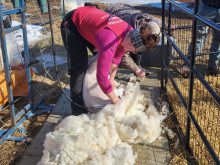Several goals must be kept in mind when looking into an artificial insemination program for a cattle operation.
Achieving pregnancies is of course the most important goal. Improving the herd’s genetic base is also important, whether the producer
is a commercial operator or seed stock breeder.
To be successful, however, producers must first consider the costs of supplies and labour.
And of course, no matter which program is used, heat detection is vital for overall success. Methods to assist in this include detector patches, heat detector paint and marker or gomer bulls.
Read Also

Charges laid after cattle theft
Saskatchewan RCMP lay two charges against a man after six cattle went missing.
The patches can lead to errors when they partially discharge after cows rub them on bushes. Producers want to see a complete red colour to verify a cow is in heat.
Gomer bulls can be beneficial in smaller breeding groups. I have tried the numerous ways that are available to create a marker animal, including implanting open cows and juicing up steers with testosterone.
The best procedure I have found is performing a epididymectomy on a smaller, quiet bull either from the producer’s herd or a known herd. It is the simplest and most economical surgery and the bull can be shipped at the end of the season.
Producers should use a poorer grade animal, preferably with smaller testicles. The cost of the procedure is much cheaper than overwintering the bull until next season.
Chin ball markers are a great help, but here’s a word of caution: let the bull get used to the marker without any ink in it for several days.
If not, the bull will mark fences, watering bowls and other structures until it gets used to wearing this new device. Changing ink colours can avoid confusing cows that have already bred.
Even though these marker bulls are full penetration breeders, disease risk is low because virgin bulls are used from a known source. It has also been found that the natural act of breeding may increase artificial insemination rates by a small percentage.
Marker bulls should not be considered if the group is too large or if synchronization is being done. Otherwise, the bulls become overworked and burned out.
Successful synchronization programs concentrate heat detection times over a few days. Producers who want to synchronize large groups of heifers should use an MGA program at 0.5 milligrams per head for 14 days, then withdraw it and either wait for the second heat or use a prostaglandin 15 to 19 days after withdrawal.
Producers who have many heifers may want to stagger the groups so calving does not overwhelm them the following year.
This program does not work successfully in cows, but programs have been developed to synchronize them. Some are labour intensive but conception rates can be good.
One shot of prostaglandin, if given at least 45 days after calving, should result in 65 to 75 percent of cows coming into heat over five days.
Other programs use GnRh first followed by prostaglandins in seven days, which will bring most cycling in over one to two days. More elaborate programs have been talked about in other articles.
Other programs are available and producers should explore each with a veterinarian to find the one best suited to their operation. They should make sure nutrition is adequate because phosphorus and energy are key for cycling to occur.
The biggest mistake a lot of producers make is to get caught up in the glamour of artificial insem-ination and lose sight of the fact they still need to get the cow or heifer pregnant early. It’s best to only artificial inseminate for one cycle and then use good quality clean-up bulls.
Heat detection is still desirable in natural breeding because it ensures the cows are actually cycling. Hand mating should occur for the first couple of breedings, especially if new young virgin bulls are used. This ensures these newcomers are successfully breeding in.
Producers should mark down dates of any breedings that they observe. This information can come in handy next year at calving if problems arise or if cows need to be induced. Only a few cows should be coming back at the next heat; other-wise the bull should be rechecked. I know of numerous cases where diligent farmers have averted a disaster by carefully watching if cows were returning to heat.
Roy Lewis is a veterinarian practising in Westlock, Alta.
















